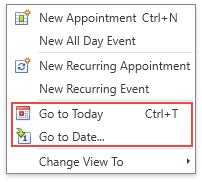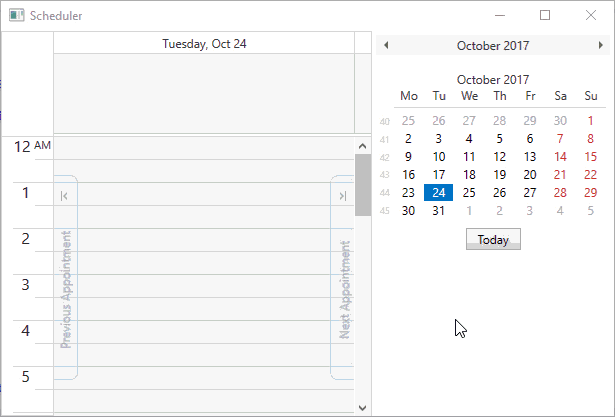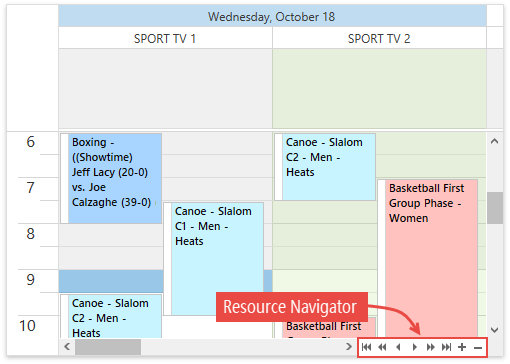Navigating
- 5 minutes to read
The SchedulerControl enables you to navigate through dates, resources, and time cells at runtime and provides necessary commands and properties to perform these actions manually.
The topic consists of the following sections:
Navigate Through Dates
You can set the SchedulerControl.Start property to specify the date on which the scheduler initially shows its data. The Start value is used to calculate the time interval displayed in the view, however the start of the visible time interval may be different, because each view can have its display restrictions.
The SchedulerControl provides the following commands to navigate through dates:
- SchedulerCommands.GoToDateCommand
- SchedulerCommands.GoToTodayCommand
- SchedulerCommands.NavigateViewBackwardCommand
- SchedulerCommands.NavigateViewForwardCommand
Use the API listed below to manually navigate through different views:
Note
The SchedulerControl does not currently support IResourceNavigationService and IDateTimeNavigationService.
End-users can navigate through dates within a scheduler using the Navigation ribbon group items:

Right-clicking within the main scheduler area invokes the context menu which contains items for navigation through dates:
- Go to Today moves focus to the current day preserving the existing view mode;
- Go to Date… invokes the Go to Date dialog for selecting a date and view type. The date can be selected using either the calendar control or by entering a string with the placeholders. Use the Show In drop-down list to select the desired view type.

Date Navigator
End-users can navigate through dates using a DateNavigator control. You can navigate to the desired month and year by clicking the corresponding arrows on the DateNavigator date header. Clicking the left and right scrolling buttons navigates back and forth by one step. Clicking the Today button navigates to the current date. The animation below shows the DateNavigator control capabilities:
Show Animation

Refer to the How to: Create the Scheduler with the DateNavigator for an example on how to provide the SchedulerControl with a DateNavigator.
Navigate Through Resources
End-users can navigate through resources and change the number of resources each page displays using the Resource Navigator. The user can click the buttons to move back and forth through the resources list; one by one, or straight to the last one on the list. The scrollbar scrolls through resources. The scheduler tracks selections and displays the corresponding resource groups. The plus and minus buttons increase or decrease the number of resources shown.

The resource navigator can only be displayed when there are visible resources. Set the SchedulerViewBase.ShowResourceNavigator property to true to enable the resource navigator. The SchedulerViewBase.ResourcesPerPage property specifies the number of resources displayed simultaneously. Both properties are individually specified for each view.
Navigate through Time Cells
The following table contains the common navigation operations available to end-users:
Action | Effect |
|---|---|
Clicking a cell | Moves focus to the clicked cell. |
Pressing the UP or DOWN ARROW key |
|
Pressing the LEFT or RIGHT ARROW key |
|
Pressing the PAGE DOWN key | Moves the row focus one page down preserving the column focus. |
Pressing the PAGE UP key | Moves the row focus one page up preserving the column focus. |
Pressing the HOME key |
|
Pressing the END key |
|
Pressing the CTRL + HOME key |
|
Pressing the CTRL + END key |
|
Pressing the TAB key | Switches focus to the next time appointment within the time span shown. Pressing the key repeatedly iterates through the appointments with a definite duration, then through all-day appointments. |
Pressing the SHIFT-TAB key | Switches focus to the previous time appointment within the time span shown. Pressing the key repeatedly iterates through the appointments with a definite duration, then through all-day appointments. |
Pressing the ALT with UP (DOWN) ARROW keys |
|
Note
When appointments are grouped, only ARROW keys can move focus to another resource group.